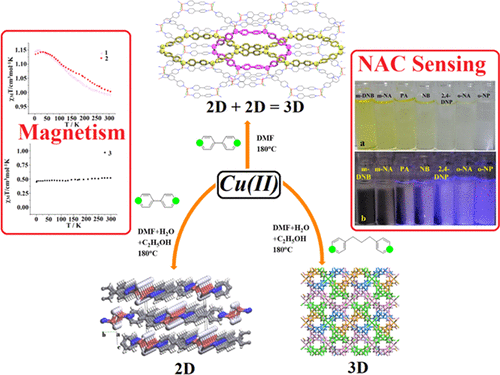ACS Omega ( IF 3.7 ) Pub Date : 2019-04-29 00:00:00 , DOI: 10.1021/acsomega.9b00715
M Naqi Ahamad 1 , M Shahid 1 , Musheer Ahmad 1 , Farasha Sama 2
Affiliation
- Department of Chemistry and Department of Applied Chemistry, ZHCET, Aligarh Muslim University, Aligarh 202002, India.
- Department of Chemistry, Indian Institute of Technology Kanpur, Kanpur 208016, India.
 |

"点击查看英文标题和摘要"
Cu(II) MOFs Based on Bipyridyls: Topology, Magnetism, and Exploring Sensing Ability toward Multiple Nitroaromatic Explosives
In this work, a series of three copper(II) metal-organic frameworks (MOFs), [Cu(4,4′-DP)Cl]n (1), [Cu(4,4′-DP)0.5Cl]n (2), and [Cu(4,4′-TMDP)Cl]n (3) (4,4′-DP = 4,4′-dipyridyl, 4,4′-TMDP = 4,4′-trimethylenedipyridyl), is designed and synthesized under solvothermal conditions. Crystallographic investigations reveal that 1 and 2 have tetrahedral and 3 has octahedral environment around the Cu(II) ion. By varying the solvent conditions and ligand derivatives, the topology can be interestingly tuned. TOPOS Pro provides topological conclusions that 1 is stabilized by unusual 2D + 2D → 3D polycatenation of layers lying in (110) and (11̅0) planes with dihedral angle of 90° showing altogether fes, hcb, and sql topologies. On the other hand, 2 exhibits a bey (3,4-c net) topology and 3 shows 4-fold interpenetration with the dia topology. The dc measurements for 1–3 performed on polycrystalline samples in a 0.1 T field confirm strong ferromagnetic behaviors for 1 and 2 and moderate antiferromagnetic behavior for 3. To examine the sensing properties of the three MOFs, various hazardous nitroaromatic compounds (NACs) were used as analytes. While 1 is a potent fluorescence sensor for highly sensitive detection of multiple NACs, 2 selectively detects meta-dinitrobenzene (m-DNB) with KSV = 5.73 × 105 M–1 and a remarkably lower limit of detection (LOD) value of 1.23 × 10–7 M. 3 does not show sensing ability toward any NAC probably due to the coordination environment being different from those in 1 and 2. The work demonstrates fine-tuning of the topology and in turn magnetic and sensing properties by changing the reaction conditions.
更新日期:2019-04-29